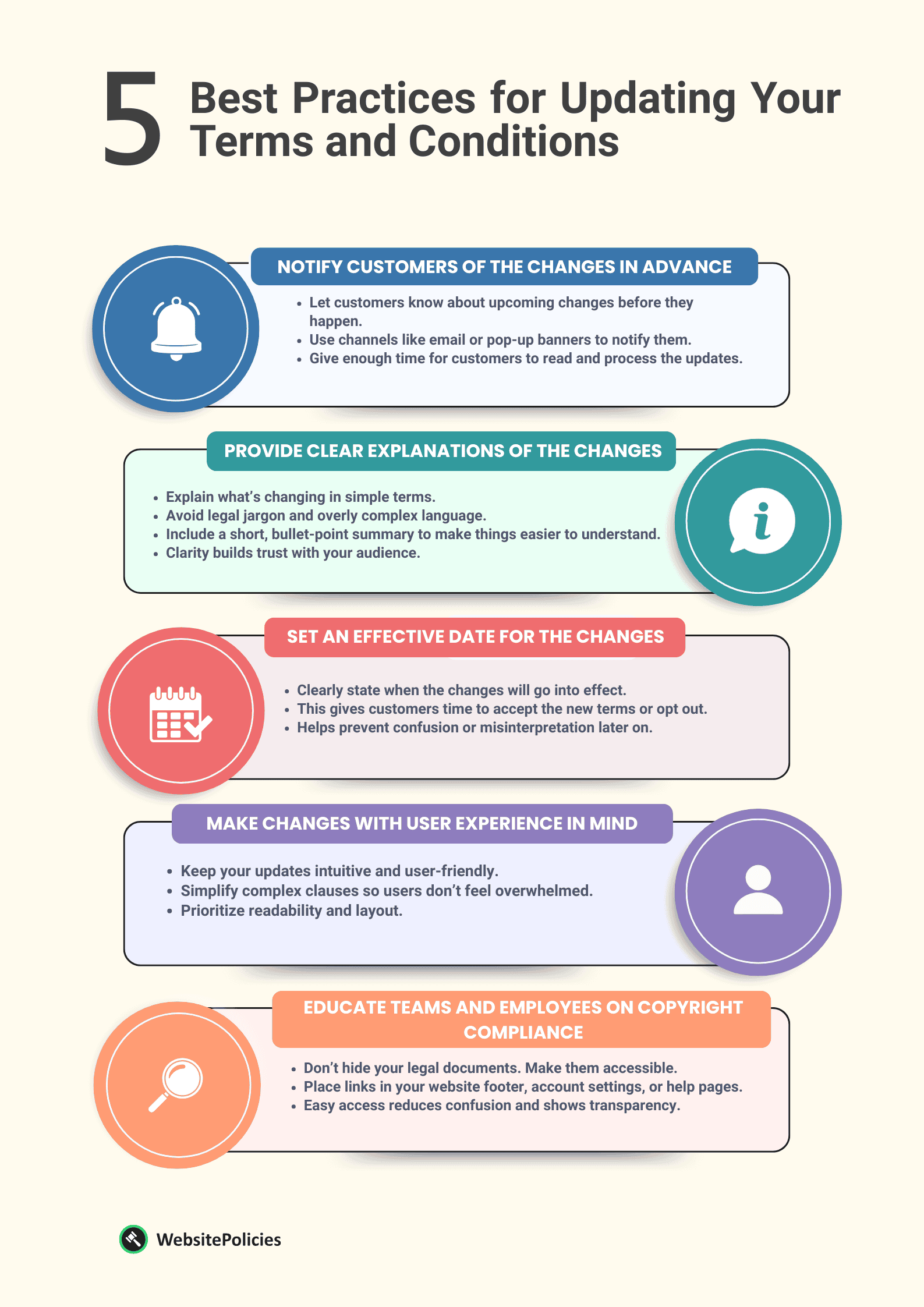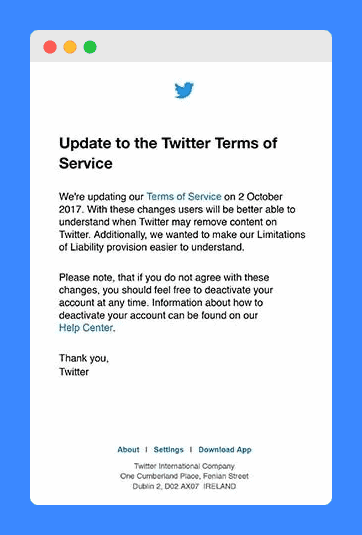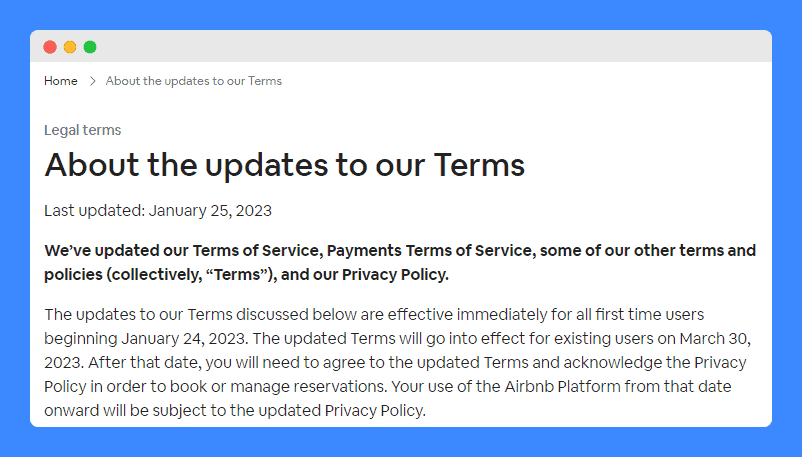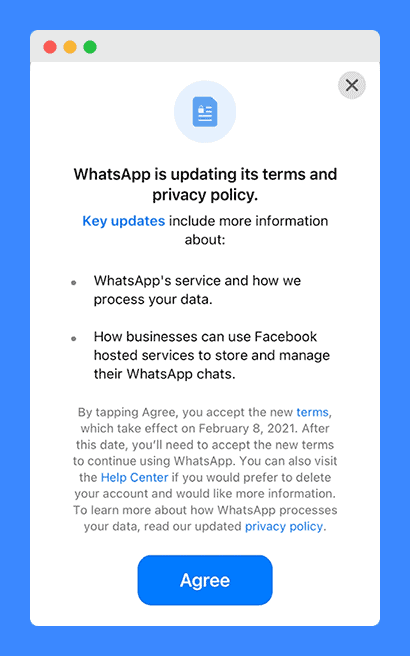Imagine you’ve spent countless hours fine-tuning your legal agreements to ensure your online business remains legally protected and transparent.
However, as your business evolves, so do your policies, and you find yourself needing to update terms and conditions.
The question is, how do you go about it and how do you notify your customers about these changes without causing confusion, frustration, or even losing their trust?
In today’s increasingly connected digital world, your customers value transparency more than ever.
In this article, I’ll dive into the importance of updating your terms and conditions on a regular basis, sending a terms and conditions change notice, the potential consequences of neglecting this step, and effective ways to communicate policy updates to your customers.
Let’s get started!
- Terms and conditions should be regularly updated to reflect business evolution and regulatory changes. They should also be communicated clearly to users, ensuring transparency.
- Failing to properly notify customers about changes in terms and conditions can lead to legal disputes, customer confusion, and loss of trust. Transparency fosters customer loyalty.
- When updating terms and conditions, effective communication methods include email notifications, website notifications, and app notifications. Allow users the option to opt-out if they disagree with changes.
Table of Contents
PRO TIP: Take the hassle of writing your own terms and conditions away with our terms and conditions generator trusted by over 200,000 businesses. It’ll save you hours of work and possible costly legal mistakes.
Can Terms and Conditions Be Changed?
Yes, terms and conditions can be changed even after your customers already agreed to them. In fact, it’s a good practice to review and update them regularly to ensure that they accurately reflect your business and comply with any changes in laws and regulations.
For example, if you decide to offer a new product or service, it’s important to update your terms and conditions to cover it. Other common changes include adjusting payment terms or handling customer-related issues.
Don’t hesitate to make changes as needed to keep the terms relevant and effective.
ALSO READ: Complete Guide to Online Terms and Conditions
PRO TIP: I highly recommend that you review and update your terms and conditions at least once a year to ensure relevancy and compliance with laws.
Can You Unilaterally Change Your Terms and Conditions?
Unilaterally changing terms and conditions means that you make changes to your website’s terms and conditions without informing your customers in advance.
I obviously wouldn’t recommend this approach because it can not only cause legal problems but even damage your reputation.
If you make a change to your terms and conditions without notifying your customers, they may feel that their trust has been violated and you may lose them as customers altogether, not to mention that you may also face legal challenges.
Best Practices for Updating Your Terms and Conditions
Having worked with numerous online businesses helping them draft and review their websites’ terms and conditions, I’ve seen my share of silly and sometimes downright unacceptable things some of the businesses do.
It always made me wonder if they even read their own terms before publishing them.
To help you avoid becoming one of those businesses, here are some of the things you can do when updating your terms and conditions:

Notify Customers of the Changes in Advance
Inform your customers of the changes you are about to make to your terms and conditions prior to making them. This can be done via email or some kind of pop-up notification on your website.
By providing plenty of advance notice, you give your customers sufficient time to review the changes and understand any possible implications.
Provide Clear Explanations of the Changes
From my experience, people appreciate transparency and appreciate it when businesses are upfront about any changes. This helps build trust with your customers and create a positive relationship with them.
Don’t try to be sneaky by using jargon or complicated wordings. It’s actually a good idea to provide a bullet-point summary of the changes to make it simple for your customers to understand them.
Set an Effective Date for the Changes
Setting an effective date for the changes is important to ensure that your customers have time to review the changes and decide if they want to continue using your services.
By providing a specific date when the changes will take effect, you won’t rush anybody to read the new terms right away and can avoid misunderstandings.
Make Changes With User Experience in Mind
When making changes to your terms and conditions, it is important to keep the user experience in mind. I have seen numerous instances where complicated changes have caused confusion and frustration.
So, it is essential to keep them as simple and straightforward as possible to ensure that customers can understand them easily.
Make Your Terms and Conditions Easy to Find
Don’t try to be sneaky and hide your legal policies. By making them easy to find, your users can always review them in case they have questions. It’ll also save you some time answering those questions.
Why You Must Send a Terms and Conditions Update Notice
Providing a change notice is not just good practice. In many cases, it’s legally required. In countries like the United States, the law requires businesses to notify customers of any changes to their terms and conditions. Failure to do so can result in legal consequences.
The ESIGN Act mandates that businesses must provide customers with a “clear and conspicuous statement” of any changes to their agreements and obtain customer consent to those changes.
Beyond legal compliance, a notice of change also demonstrates transparency.
It builds a foundation of trust with your customers by showing them that you value their trust and are committed to being transparent about any updates to your policies. This can lead to increased customer loyalty and retention.
Additionally, it can help ensure the enforceability of your agreement. If you make changes to your policies without informing your customers, those changes may not be legally enforceable in the event of a dispute.
By providing an advanced notice, you’re giving your customers the opportunity to review and agree to the updated terms, which can help protect your business in the long run.
PRO TIP: When creating a change notice, make sure it’s written in clear and concise language that your customers can easily understand. Avoid using legal jargon or technical terms that may confuse them.
Consequences of Not Notifying Your Users
Failing to provide any notifications can have serious consequences for your business. Not only is it a legal requirement in many countries, but it’s also essential for maintaining trust with your customers.
Here are some of the potential consequences of not providing a change notice:
Legal Disputes
If you make changes to your agreement without notifying your customers, you could be opening yourself up to legal disputes. In the event of a disagreement or misunderstanding, customers could argue that they weren’t aware of the update, which could put you in a vulnerable legal position.
Customer Confusion
Without being notified, your customers may be unaware of any updates to your policies. This can lead to confusion, misunderstandings, and even frustration, which could negatively impact your business reputation.
Loss of Trust
Customers value transparency and honesty from businesses. Failing to notify your customers can disrupt trust and make them feel like you’re not being transparent about your business practices. This can lead to a loss of customer loyalty and potentially negative reviews.
For example, let’s say that you’re a subscription-based online business that recently changed its billing practices. If you don’t let your customers about it, they will likely not be aware of the new billing terms.
This could lead to confusion and frustration, and potentially cause customers to cancel their subscriptions.
In contrast, by keeping them in the loop, you can ensure that your customers are aware of the updated terms, which can help build trust and maintain positive customer relationships.
PRO TIP: In the U.S., Federal and several state laws offer protection to consumers from unfair, deceptive, and fraudulent business practices. Hiding unusual terms deep in the fine print of your agreement could be considered misleading. Make sure your terms are reasonable and fair.
ALSO READ: Terms and Conditions Template and a List of Required Clauses
How to Send a Terms and Conditions Update Notice?
Once you’ve decided to make changes to your terms and conditions, the next step is to effectively communicate these updates to your customers.
In this section, I’ll explore different methods used by successful online businesses to notify their customers of any changes to their policies.
Email Notification
One of the most common methods for notifying customers of changes to your terms and conditions is through email. Send a clear and concise email outlining the changes, the effective date, and what actions customers need to take, if any.

Website Notification
Posting a notice on your website can be an effective way to inform customers of any changes to your policies. Make sure the notice is prominently displayed on your website and easy to find.

App Notification
If you have an app, consider sending a push notification to notify customers of the changes. This is a great way to reach customers who may not check their email or visit your website regularly.
You can also prompt users to review and consent to the updated terms before they continue to use the app.

PRO TIP: The General Data Protection Regulation (GDPR) requires you to include in the notice any changes that were made in handling consumer data or acquiring additional info from your consumers.
Regardless of the method you choose, you must allow customers to opt-out or close their accounts after receiving notice, which gives them the opportunity to decide whether or not they want to continue using your service under the updated terms.
When notifying customers of changes to your terms and conditions, it’s important to be transparent and clear. Make sure customers understand the changes and what actions they need to take.
Additionally, make sure the notice is easy to find and prominently displayed.
Finally, be responsive to any customer questions or concerns that may arise. It will help build trust with your customers and maintain positive customer relationships.
Frequently Asked Questions
Can terms and conditions be changed after customers have agreed to them?
Yes, terms and conditions can be updated as necessary to reflect changes in the business or regulations.
How often should terms and conditions be reviewed and updated?
It’s recommended to review and update your terms and conditions at least once a year to maintain relevancy and legal compliance.
Is it legal to change terms and conditions without notifying customers?
Unilaterally changing terms and conditions can cause legal issues and damage your reputation. It’s best to inform customers.
How can I effectively notify customers about changes in terms and conditions?
Common methods include email notifications, website notifications, and app notifications, each clearly outlining the changes and an effective date.
Should I give customers the option to opt-out if they disagree with changes in terms and conditions?
Yes, providing an opt-out option after notifying them about the changes gives customers the chance to decide about continued use.



